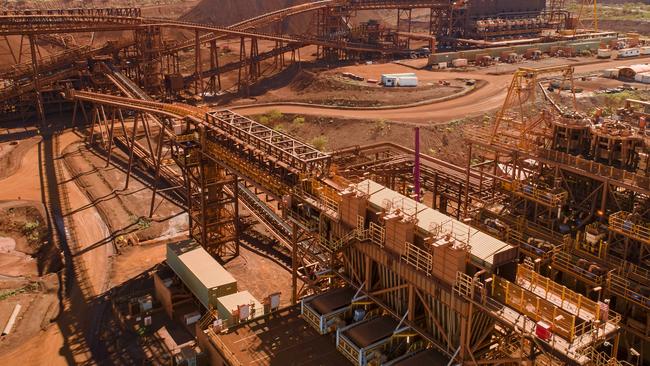Fortescue’s green spending could put pressure on dividend payouts if iron ore softens, analysts say
With Fortescue’s green spending under renewed scrutiny, analysts are asking whether the company can save the world as well as saving shareholder dividends.

Fortescue’s dividend could come under pressure as the company ramps up spending on its green energy projects, analysts say, despite the sweeping wave of redundancies flagged by the company.
Fortescue said in its quarterly production report on Thursday that it still intended to spend $US1.2bn ($1.83bn) on its green energy arm in the current financial year, including operating and capital costs.
The company has a policy of paying out 50 to 80 per cent of its net profits in dividends, which has delivered a river of cash to shareholders as the iron ore price held up in recent years, with Andrew and Nicola Forrest’s family interests the biggest beneficiary.
But Fortescue flagged an increase in spending on its green hydrogen and energy ambitions this financial year, despite the company’s decision last week to shed about 700 jobs as it looks to reduce costs and reduce duplication of back-end functions between its energy and mining arms.
Fortescue is also forecasting capital spending of $US3.2bn to $US3.8bn in its iron ore operations – including $US700m to $US900m on decarbonisation spending – and this week said cash production costs could run close to $US20 a tonne this financial year, with the company giving a guidance range of $US18.50 to $US19.75 a tonne.
Combined with widening discounts for lower-grade iron ore exports, all of that could put the company’s dividend policy under pressure, analysts say, with Macquarie suggesting Fortescue could have to extend its borrowing to maintain dividend payouts.
“Whilst management spoke of a lean focus and 700 jobs were cut across the business, under our price forecasts Fortescue’s minimum 50 per cent payout ratio comes under pressure. To sustain the dividend policy, we believe FMG may need to increase gearing,” Macquarie said in a client note on Friday.
Goldman Sachs analyst Paul Young noted the company’s capital spending was increasing to maintain production at some of its older mines, and may need to ramp up spending again if new green hydrogen projects in Norway and Brazil – now going through feasibility studies – are given the green light by the company’s board.
“We continue to think Fortescue is at an inflection point on capital allocation, and to fund the ambitious strategy, we assume the company reduces the dividend payout ratio from the current 65 per cent in the second half of FY24 to about 50 per cent from FY25 onwards – the bottom end of the 50 to 80 per cent guidance,” he said.
Fortescue narrowly missed its annual export targets, shipping 191.6 million tonnes of the year, just under the bottom end of its 192 to 197 million tonne guidance range.
But, after Fortescue’s troubled Iron Bridge magnetite project again missed expected export rates, the company only came close to its overall export target after shipping far higher quantities of a lower grade product known as Super Special Fines, which made up more than half of its record June quarter exports.
The iron ore major says it expects Iron Bridge to ramp to production rates of 5 to 9 million tonnes this financial year, after shipments of only 1.2 million tonnes in the year ending June 30.
But Fortescue has also widened its overall export guidance target, flagging shipments of 190 to 200 million tonnes.
That suggests shipments from some of its hematite mines could taper off this year, according to Morgans analyst Adrian Prendergast.
“Management denied this view, commenting that changes in FY25 will only be minor, but the facts are hard to dismiss,” he said.
“The lack of commentary makes it hard to identify the drivers of the change, but it is clear that FMG has been pushing some of its ageing mines hard with strip ratios rising and the need for increased mine replacement invariably increasing.”
While Mr Prendergast said he still expects Fortescue to maintain dividend yields above those of its competitors, softening iron ore prices could put pressure on shareholder payouts.
“Fortescue maintains a healthy balance sheet, but its capex-heavy mine replacement, decarbonisation, and sustainability investments are placing an increasing load on its base iron ore business in terms of capital requirements. Unexpected weakness in iron ore prices could see significant dividend pressure,” he said.
Fortescue shares were up 21c to $20.35 at 1400 AEST.




To join the conversation, please log in. Don't have an account? Register
Join the conversation, you are commenting as Logout